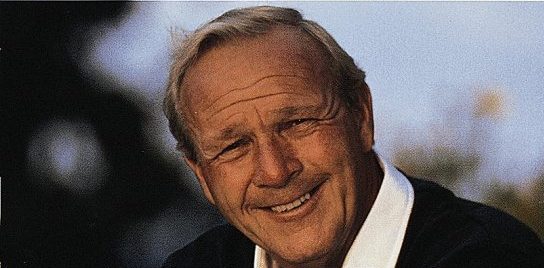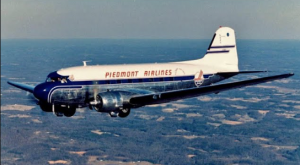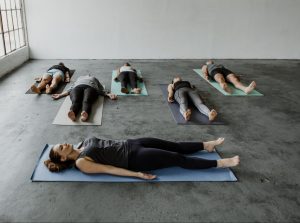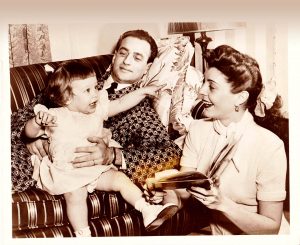
The King of Everyman
By James Dodson
Global Golf
Originally published in October 2016
Around five o’clock last Sunday afternoon my wife Wendy and I were watching a late afternoon football game when I was suddenly felt overcome by a chill and uncommon queasiness and needed to go upstairs to lie down for an hour before friends came for supper.
I’m rarely sick and assumed this peculiar spell was simply brought on by fatigue from working since four in the morning on a golf book I’ve been writing for almost two years, a personal tale called the Range Bucket List.
The first chapter and the last one are about my friend, collaborator and boyhood hero Arnold Palmer.
The first chapter explains that he was the first name on what I called my Things to Do in Golf List around1966 after falling hard for my father’s game and reading somewhere that my Arnold Palmer started out in golf by keeping a similar list of things he intended to do in the game. Many decades later, while interviewing him one morning early in his workshop in Latrobe, I confirmed this fact with the King of Golf.
The final chapter details the emotional visit I made to see him at home in Latrobe about a month before his 87th birthday. I knew he wasn’t doing particularly well. When I walked into his rustic house on Legends Drive in the unincorporated Village of Youngstown on the outskirts of Latrobe, I found the King of Golf watching an episode of Gunsmoke, the number one American TV show about the time Arnold Palmer was the world’s number one golfer.
He greeted me warmly without getting up. A walker was standing nearby. His second wife, Kitt, brought me a cold drink. He turned down the sound and we had a nice time catching up, almost — but not quite — like many intimate conversations we’d over over the past two decades. Arnold’s once seemingly invincible blacksmith body had finally given out yet his mind and spirit were strong. He insisted on joining Doc Giffin, his longtime assistant, Kitt and me for an early supper that evening across the vale at Latrobe Country Club.
The trip was like a homecoming for me – and something I feared would be a farewell.
For two full years from early 1997 to late 1999 I had the privilege of serving as Arnold Palmer’s collaborator on his autobiography A Golfer’s Life. I was deeply honored to have been chosen by Arnold and wife Winnie for the project, and touched that he insisted that my name share the cover and title page of the work. I always called the book his book. He always called the book our book.
Not long after we began working it – both being unusually early risers who often chatted in his home workshops before official business hours — Winnie was diagnosed with a form of ovarian cancer and Arnie – which is what he insisted I call him, though I never could quite make myself do so – withdrew from his busy public life so we could get the book completed and published before time took its toll, narrowing the horizon of what was supposed to be a three year project to just under two.
We brought the book out in time to celebrate Arnold’s 70th birthday in September 1999 and the opening of a beautiful restored red barn that Winnie had always loved just off the 14th fairway at the same club where Arnold grew up under the firm watch of his demanding papa, Deacon Palmer, whom Arnold simply called “Pap.”
Rather than a conventional autobiography of facts and figures and tournament highlights, my objective with Arnold’s book was to create an unusually warm and intimate reminiscence or memoir that read as if Arnold and his fans were simply sharing a drink after a day of golf and he was quietly relating the 15 or so key moments of his life, revealing how these moments shaped the most influential golfer in history and arguably America’s greatest sportsman ever.
Both the Winnie’s barn and Arnold’s book were a hit. The book was on the bestseller list for almost half a year. The handsome red barn stands in quiet tribute to them both. Winnie passed away less than two months after that special evening Arnold turned 70.
After lying down and lightly dozing for an hour, I heard our guests arriving and got up to go downstairs. The cold and queasiness had passed and I felt much better — only to find my wife waiting at the bottom of the steps holding out my mobile phone with a very sad look on her face.
A nice person named Molly from NBC News in New York was on the other end, wanting to know if I could confirm a report that Arnold Palmer had passed away.
We spoke for an hour as my incoming call alert continued to light up from news organization around the world. By midnight I’d spoken with reporters from all the major networks, several cable news organizations, CNN International, a pair of wire services, the Canadian Broadcasting System and Australia’s leading sports call-in show – all of it testament to the drawing power of Arnold Daniel Palmer.
The conversations about his unprecedented life and times and seismic impact on popular culture and the world of sports went well into the early morning hours.
Was the cold and queasiness coincidence or something more sympathetic in nature?
That’s impossible to say. This much is certainly true: As Winnie commented early in our collaboration, Arnold and I enjoyed unusually strong chemistry and an uncommon connection that is instinctively felt and shared by his millions of adoring fans — and was still apparent last month when I visited with him at home.
The morning after our dinner at the club, I also visited with Doc Giffin and Arnold’s amazing staff at Arnold Palmer Enterprises and even saw his younger brother Jerry when he popped in to say hello.
Finally the boss showed up for work around 10 o’clock, trailed by a couple cheerful young therapists from the local hospital who were planning to do a stretching and exercise session at the Palmers’ home gym aimed at restoring Arnold’s ability to swing a golf club again.
As he signed books and the usual stack of photos and personal artifacts from fans that are always waiting for his immaculate signature every morning of his life, we chatted about various family matters and other things large and small. With Doc and his therapists we even watched a recently colorized CD release of the historic 1960 Masters where Arnold closed from two shots back to claim his second Green Jacket, setting off a national frenzy in the process.
At one point as we watched him teeing off on the 72nd hole of the tournament, needing a clutch birdie to secure the win, Arnold declared excited – “There, girls! There’s my golf swing!”
The therapy girls were standing directly behind the King of Golf. They were beaming, part of a new generation that never had the pleasure of experiencing the game’s most compelling star in his prime.
Arnold’s eyes was alive with pure joy. There were tears pooling in his eyes.
And even bigger tears pooling in mine.
Doc Giffin, a legend in his own right, just smiled from a few feet away.
A little while later, I did something I’d meant to do for many years.
I handed him my first hardbound copy of A Golfer’s Life and asked him to autograph it.
He accepted the book but gave me what I fondly call The Look – a cross between the scowl of a disapproving school master and a slightly constipated eagle, one way he loves to needle his friends.
I watched as he took his own sweet time writing something on the title page. He handed me back the book and said, “Don’t open this until you’re safely home.”
Facing a nine hour drive home to North Carolina, I somehow managed to wait until I reached my driveway just as the summer day was expiring, at which point I opened the book. He could have written it to 100 million people around the world, all of whom share the same kind of connection with the King of Everyman – and women.
“Dear Jim,” he simply wrote. “Thanks for all your wonderful works. You are the greatest friend I could have – Arnold”
That’s when my waterworks really let loose a gusher.
Over the days and week to come, we’ll all be reminded of Arnold Palmer’s extraordinary impact on golf and American life in general and the mammoth-hearted legacy he leaves behind:
How his 62 PGA Tours wins, 90 tournament victories worldwide and seven major championships defined the life of a man from the rural heartland of Western Pennsylvania who almost singly pioneered the concept of modern sports marketing, created a business model that turned into an empire stretching from golf tees to sweet tea, and grew to be golf’s most visible and charismatic force, its greatest philanthropist and most beloved ambassador.
During his half century reign, and largely because of him, in my view and that of many fellow historians, golf enjoyed the largest and longest sustained period of growth in history, a remarkable period that included the formal creation of no less than six professional tours, witnessed television’s incomparable impact, saw the rebirth of the Ryder Cup and revival of European golf, the rise of international stars and nothing less than a scientific revolution in the realms of instruction, equipment technology and golf course design – all of which Arnold played some kind of role.
How much of this cultural Renaissance was due to this kind, genuine, fun-loving and passionately competitive family man who grew up showing off for the ladies of Latrobe Country Club and earning nickels from them by knocking their tee shots safely over a creek on his papa’s golf course?
Impossible to fully quantify, I suppose. Though I would be inclined to say just about everything.
Golf is the most personal game of all, a solitary walk through gardens of nature. And Arnold Palmer was the most personal superstar in the history of any sport, a true blue son of small town America, the kid next door who grew up to become a living legend, a homegrown monarch for the Everyman in each of us, a King with a common touch.
His charm and hearty laugh and extraordinary undying love of the ancient game he was meant by Providence to elevate like nobody before him, will surely live on as long as people young and old tee up the ball and give chase to the game.
But he will be missed.
Oh, how Arnold Palmer will be missed by each and every one of us in a truly personal way.





